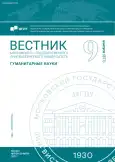Modelling Writing Based on Keyloggers Data and Distributional Semantic Models: Justification of Methodology and Research Program
- 作者: Litvinova T.A.1
-
隶属关系:
- Voronezh State Pedagogical University
- 期: 编号 9(877) (2023)
- 页面: 35-40
- 栏目: Linguistics
- URL: https://journal-vniispk.ru/2542-2197/article/view/333348
- ID: 333348
如何引用文章
全文:
详细
In modern experimental psycholinguistics, keyloggers (i. e., programs for recording keyboard behavior) are actively used. Their application made it possible to obtain new scientific data on the process of text production, but at the same time led to the emergence of various contradictory information. We propose to supplement the methodology of text generation studies using keyloggers with data from distributional semantic models on the semantic distance between words.
作者简介
Tatiana Litvinova
Voronezh State Pedagogical University
编辑信件的主要联系方式.
Email: centr_rus_yaz@mail.ru
Doctor of Philology (Dr. habil.), Leading Researcher in Computer Semasiology Laboratory, Voronezh State Pedagogical University
俄罗斯联邦参考
- Leijten, M., Van Waes, L. (2013). Keystroke logging in writing research: Using Inputlog to analyze and visualize writing processes. Written Communication, 30(3), 358–392.
- Gluxov, V. P. (2005). Osnovy psyholingvistiki = Foundations of psycholinguistics. Moscow: AST: Astrel. (In Russ.)
- Mahlow, C., Ulasik, M. A., Tuggener, D. (2022). Extraction of transforming sequences and sentence histories from writing process data: a first step towards linguistic modeling of writing. Read Writ.
- Kibrik, А. А., Podlesskaya, V. I. (eds.). (2009). Rasskazy o snovideniyah: Korpusnoe issledovanie ustnogo russkogo discursa = Stories about dreams. A Corpus study of Russian oral discourse. Moscow: LRC Publishing House. (In Russ.)
- Cislaru, G., Olive, T. (2018). Le processus de textualisation. Analyse des unités linguistiques de performance écrite. Louvain-la-Neuve: De Boeck Supérieur. (In French).
- Baaijen, V. M., Galbraith, D., de Glopper, K. (2012). Keystroke analysis: Reflections on procedures and measures. Written Communication, 29(3), 246–277.
- Conijn, R. et al. (2022). A product-and process-oriented tagset for revisions in writing. Written Communication. 39(1), 97–128.
- Miletic, A., et al. (2022). Pro-TEXT: an Annotated Corpus of Keystroke Logs. In Proceedings of LREC (pp. 1732–1739).
- Goodkind, A. (2021). TypeShift: A User Interface for Visualizing the Typing Production Process. arXiv preprint arXiv:2103.04222
- Vandermeulen, N., Steendam, E. Van, Rijlaarsdam, G. (2023). Writing Process Feedback Based on Keystroke Logging and Comparison with Exemplars: Effects on the Quality and Process of Synthesis Texts Written Communication, 40(1), 90–144.
- Meulemans, C. et al. (2022). Cognitive Writing Process Characteristics in Alzheimer’s Disease. Frontiers in psychology, 13. 10.3389/fpsyg.2022.872280.
- Holmlund, T. B. et al. (2022). Towards a temporospatial framework for measurements of disorganization in speech using semantic vectors. Schizophrenia research. 10.1016/j.schres.2022.09.020.
- Heinen, D. J. P, Johnson, D. R. (2018). Semantic distance: An automated measure of creativity that is novel and appropriate. Psychology of Aesthetics, Creativity and the Arts, 12(2). 10.1037/aca0000125..
- Beaty, R. E., Johnson, D. R. (2021). Automating creativity assessment with SemDis: An open platform for computing semantic distance. Behavior research methods, 53(2), 757–780.
- Litvinova, T. (2020). Process-oriented characteristics of an idiolect for authorship attribution of heterogeneous texts: A pilot study. CEUR Workshop Proceedings, 2780, 3–16.
补充文件










